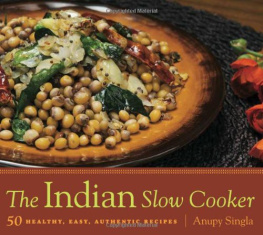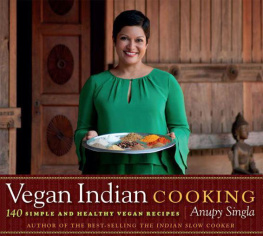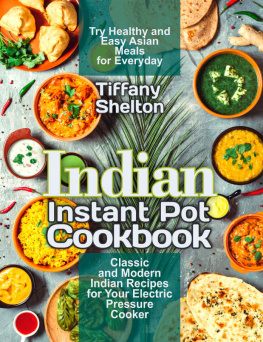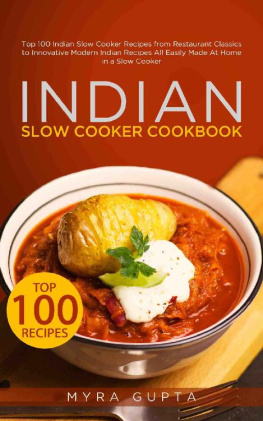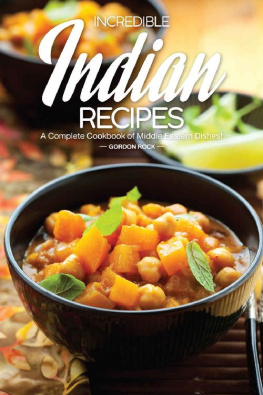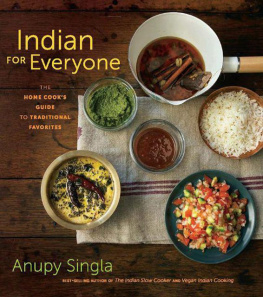Table of Contents
Mom, here is your book.
Acknowledgments
THIS BOOK IS A TRUE FAMILY EFFORT.
The most credit goes to Veena Singla, my incredibly patient mother, who has written her own cookbook ten times over during the course of the last two decades. Hers was handwritten on index cards and small slips of paper that she would steadfastly and eagerly hand to me through my various stages of life and work, first as an aide on Capitol Hill, then as a graduate student in Hawaii, and still later as a mother myself trying to balance work, kids, and a hungry husband. Mom, Im writing this for us and to tell you how much I appreciate your persistence and desire to teach your children that cooking can be easy, nutritious, and Indian.
I also want to thank my father, who often showed so much enthusiasm for this project that he kept me on the phone for hours at a time, going over one recipe after another. Dad, its your love of spicy, authentic Indian food that makes these recipes a representation of everything that is important to our family. You know that Babaji is responsible for all of this. After all, hes the one who gave me my first cooking lesson.
I was also blessed to have a mother-in-law who uses a slow cooker and a father-in-law always willing to taste test. Mattu Massi and Nisha Mamiji, we combined your years living in India with my Indian-American outlook to create unique recipes that are still true to their roots. It was so much fun to exchange recipes with you, and I know this project will connect us in a way we never thought possible.
A huge thank you to my husband and children, who patiently let me experiment on them every step of the way. Granted, I sometimes wonder how I ever finished a book with so many needs to fulfill throughout my day (from bouts of crying, to fighting, to dead fish). But, I have to say, you all helped me realize that the craziness was worth it.
Nehamy older and more organized oneyou are the best agent Ive ever had. And affordable: You only asked for a quarter per book in return and sold this book to all of your kindergarten classmates and teachers while it was still a mere idea. I learn from your steadfast drive and ambition every day.
Aria, you are hands down the best taste tester anyone could hope for. My younger one, at four years old, would leave Dora, SpongeBob, and Tom and Jerry (her absolute favorite) by the wayside as soon as she saw I was cooking. Aria, you were brave enough to try anything, from fresh spinach to raw garlic. I love you and your amazing spirit.
Sandeepwhat can I say? You love to eat. Thank god youre obsessed with raw onions, too! We couldnt have done better.
The first person outside my family I approached about this book was Donna Pierce, at the time assistant food editor and test kitchen director for the Chicago Tribune s food section. I cold-called you, asking for help, and you were nothing but open and encouraging. For that, I thank you wholeheartedly. Youve been a voice in the back of my head all through this process.
A huge thank you to all of my amazing taste testers, many of whom I met randomly along the way and who meekly responded yes when this persistent stranger asked, Do you like Indian food? I figured, who could resist free food? Thank goodness you were all up to the challenge. You made my book better with your honest and thoughtful feedback. And, a big thank you to the folks at Peets Coffee and Tea on North Avenue in Chicago, who let me sit and write for hours at a time.
Many thanks to my brilliant photographers Dave and Gregg and food stylist Kathy, whose enthusiasm for this project clearly shows through their mouth-watering images. Twenty dishes in two days with two sick kidswe still did it!
I would be remiss if I forgot to thank my fellow victims in boot camp at the East Bank Club. Through this class, I culled many a writing opportunityeven this book. It was Amy who introduced me to Janet Fuller, the food editor at the Chicago Sun-Times . As soon as I told Janet about my book idea, she put me in touch with my now publisher, Doug Seibold, and the rest is history.
My most sincere thank you goes to Doug. Without your leap of faith, this book would never have existed. You took me on, though this was my first book project. I will never forget the help and the guidance!
Introduction
MY PARENTS MOVED TO AMERICA WHEN I WAS THREE, and after a series of moves, we ended up in King of Prussia, Pennsylvania. Growing up, I ate Indian food almost every day (except for those bouts of boardwalk fries and Steak-umms). I spent many summers in India, watching my paternal grandmother and others in her village make many of the recipes in this book. There, they mash spices by hand and toil over hot clay stoves for hours at a time. They also use pressure cookers, which are fast but often intimidating.
As a television reporter and a writer, I just didnt have the luxury of extra time in my day (who does?), but I was determined to find ways to produce traditional Indian flavors without all the work. Dont get me wrong, some grinding and chopping is still involved in these recipes. But, with the right tools, even those tasks are not complicated. You just have to know which spices and kitchen appliances to have on hand. This book will spell it out for you.
My mother was a typical immigrant to this country: busy with work, but well versed on how to stock our kitchen with the appropriate spices and utensils to make the foods that she and my father grew up eating. But even Mom grew a little weary of tending to dish after dish on the stovetop.
My mom was first introduced to the slow cooker in the 1970s by a coworker. It was the first time shed ever heard of one, as they didnt exist in India back then. Mom says she began by cooking soups but then began to experiment with Indian food. She became hooked when she realized it saved hours of her time without sacrificing taste.
There are hundreds of Indian cookbooks out there and even more books on slow cooking. But never has one put the two concepts togetheruntil now.
Indian food traditionalists will likely raise an eyebrow. Most Indian dishes are based on making a tardka infusing extremely hot oil with whole and ground spices to season your dish. Usually, after a curried dish is prepared, oil or ghee is heated in a separate frying pan. Just as the oil begins to smoke a bit, cumin, mustard seeds, and other whole spices are added, along with chopped or sliced onions, ginger, and garlic. This mixture is then added to the prepared curry dish just before serving, enhancing its flavor. Some of my friends who use slow cookers still finish off their dishes with a fried tardka .
After much experimentation, Ive discovered that for most dishes you can eliminate this step without sacrificing taste, reducing the hands-on prep process to a mere twenty-minute affair and eliminating virtually all fat. I have included the tardka process in a few dishes that I believe still need itespecially those that use mustard or fenugreek seeds, as without the hot oil the seeds wont pop or roast to the right flavor.

